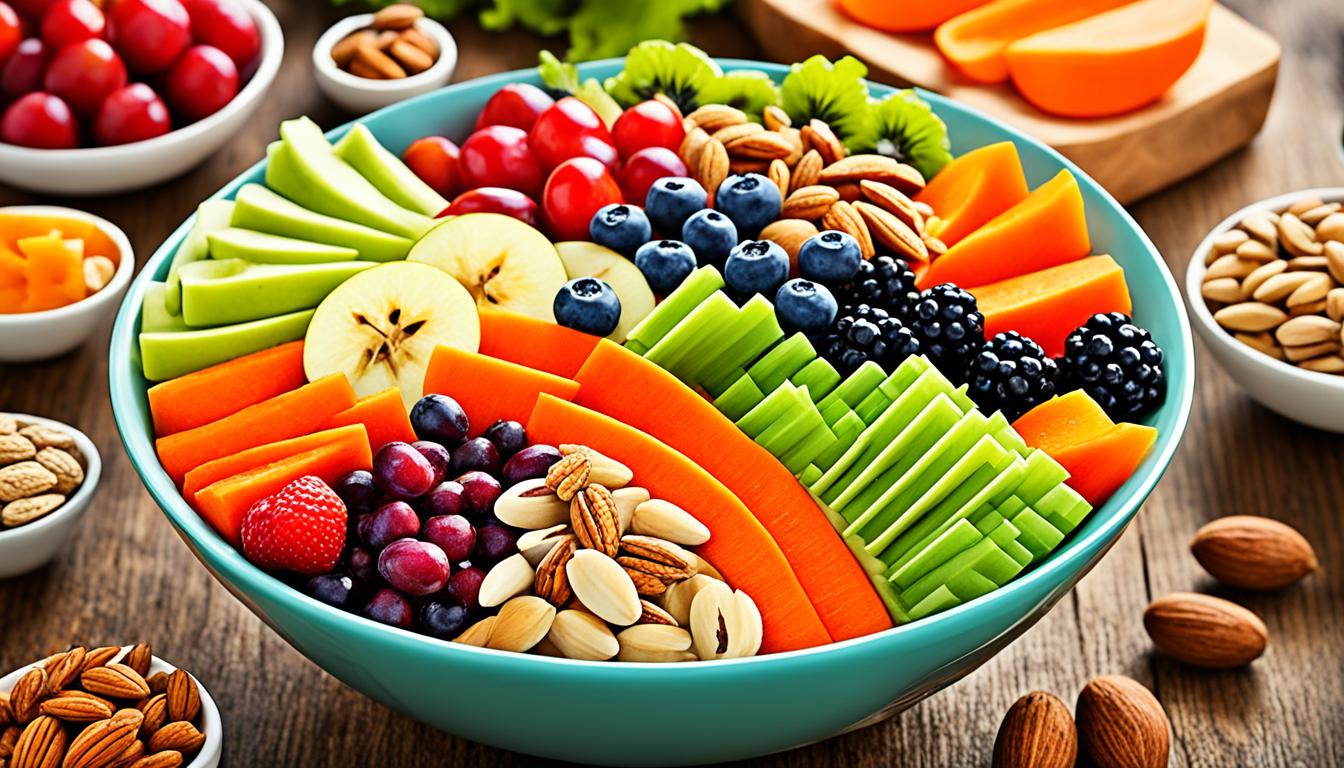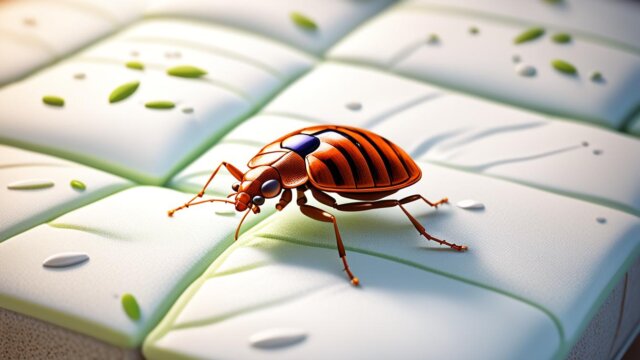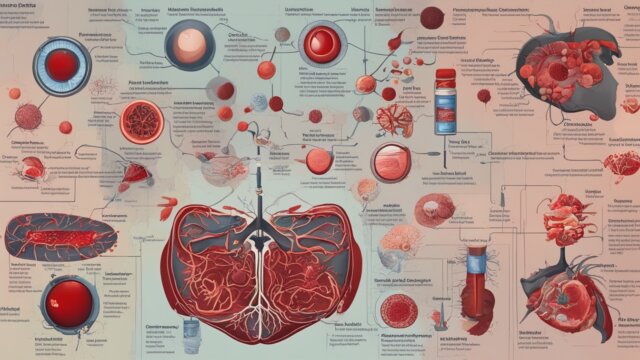FTC disclaimer: This post may contains affiliate links and we will be compensated if you click on a link and make a purchase.
Only 5% of North Americans get enough fiber in their diet. If you’re gluten-free, finding fiber-rich foods is key. They can make a big difference in your health. This article shares many yummy and healthy gluten-free foods. They are high in fiber and good for you.
Grains, seeds, legumes, and nuts are full of fiber and taste great. They keep you full, help your gut, and give you needed nutrients. This guide will help you add more gluten-free grains and plant-based proteins to your meals.
Key Takeaways
- Discover a variety of delicious and nutritious fiber rich gluten free foods to boost your intake of this essential nutrient.
- Learn about the importance of fiber in a gluten-free diet and how to overcome challenges of getting enough fiber without gluten.
- Explore nutrient-dense gluten-free grains and seeds, as well as fiber-packed legumes and pulses.
- Discover fiber-boosting snack ideas and high-fiber gluten-free breakfast options to incorporate into your daily routine.
- Gain inspiration from global cuisines and learn how to balance fiber intake with hydration for optimal gut health.
Introduction to Fiber-Rich Gluten-Free Living
Living gluten-free can be hard, especially when trying to get enough fiber. Fiber is super important for our health. It helps with digestion, keeps our blood sugar stable, and makes us feel full. Because gluten grains are a big source of fiber, cutting them out makes getting enough fiber tough.
Importance of Fiber in a Gluten-Free Diet
Fiber keeps our stomach healthy by making sure things move smoothly. It stops constipation and helps good bacteria in our gut grow. It also keeps our blood sugar from jumping around, which keeps diseases like diabetes away. Besides, it makes us feel full, important for those watching their weight.
Challenges of Getting Enough Fiber Without Gluten
Going gluten-free might mean less fiber since many high-fiber foods are not allowed. But, the gluten-free market is growing, offering new options. Still, not every gluten-free product is healthy. Some are high in bad stuff like fats and sugars, but low in fiber. That’s why it’s key to check labels and choose whole foods when trying to up your fiber game.
To get more fiber in a gluten-free way, plan meals carefully. Use grains, beans, fruits, and veggies that are gluten-free but packed with fiber. This way, you’ll keep your body happy and healthy.
Gluten-Free Grains and Seeds with High Fiber
Adding more fiber to your gluten-free diet is easy. There are many grains and seeds packed with nutrients. Quinoa is well known for its fiber content. And teff, sorghum, and millet are also great choices.
Quinoa: A Nutrient-Dense Superfood
Quinoa is special because it’s a complete protein. This means it has all nine essential amino acids. A cup (185 grams) of cooked quinoa gives you 5 grams of fiber and 8 grams of protein. It also has important nutrients like magnesium and phosphorus.
Teff, Sorghum, and Millet: Underrated Fiber Heroes
Teff, sorghum, and millet aren’t as famous, but they are full of fiber. For example, teff has 10 grams of protein and 7 grams of fiber in a cup (252 grams). It’s also rich in B vitamins. Sorghum, on the other hand, offers 13 grams of fiber and 20 grams of protein in a cup (192 grams), plus 19% of your daily iron needs. Millet is a powerhouse with 17 grams of fiber in a cup (174 grams).
Use these grains in pilafs, salads, baked goods, and snacks. They are fantastic for increasing the fiber in your meals while keeping you full and satisfied.
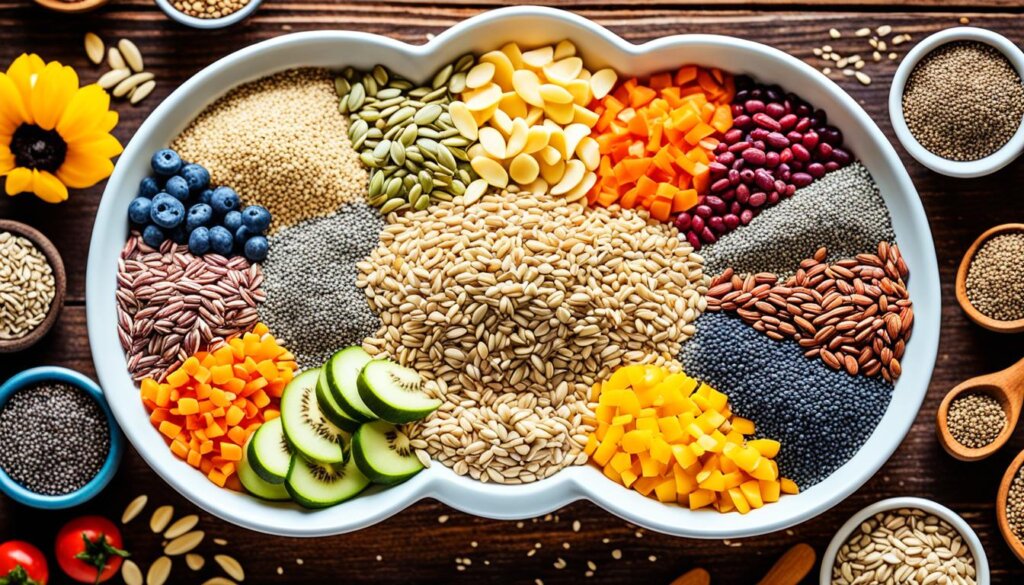
“Incorporating a variety of gluten-free grains and seeds into your diet is a great way to increase your fiber intake while still avoiding gluten. Quinoa, teff, sorghum, and millet are all excellent choices that offer a range of additional nutrients beyond just fiber.”
Exploring high-fiber gluten-free grains and seeds is beneficial. It not only adds variety to your food but also makes meals nutritious. Quinoa, teff, sorghum, and millet are healthy choices for a gluten-free kitchen.
Fiber Rich Gluten Free Foods: Legumes and Pulses
On a gluten-free diet, finding nutrient-rich, high-fiber foods is key. Legumes and pulses fit the bill perfectly. They are full of fiber, protein, and important vitamins and minerals. These make them great for a gluten-free way of eating.
Chickpeas: Versatile and Packed with Fiber
Chickpeas, also known as garbanzo beans, are rich in fiber. They contain 6.4 grams per 100 grams. You can roast or blend them into hummus. They are also a great addition to salads, soups, or stews. Eating ½ cup or more of pulses daily leads to consuming more fiber, protein, and various important nutrients.
Lentils, Beans, and Peas: Filling Fiber Powerhouses
Lentils, beans, and peas are excellent sources of fiber. Lentils have 7.9 grams per 100 grams. Navy beans, pinto beans, and black beans offer even more. With 10 grams of fiber in just ½ cup cooked, beans are a top choice for fiber and protein. Green peas are rich in fiber too, with 4.1-5.5 grams per 100 grams.
Adding these legumes and pulses to your gluten-free meals can boost your fiber intake. This is good for your digestion and metabolism.
Nuts and Seeds: Crunchy Fiber Boosters
Eating gluten-free means hunting for fiber-rich foods that fit in your meals. Nuts and seeds are a great pick. They’re not just tasty but full of fiber.
Using almonds, peanuts, and pecans in your meals adds good fiber. They offer 15, 12, and 10 grams of fiber in a cup. Flax seeds are high in fiber and omega-3s, a real health boost. Chia seeds have 10 grams of fiber in only 2 tablespoons.
- Nuts like almonds, peanuts, and pecans help a lot with fiber on a gluten-free diet.
- Seeds like flax and chia are rich in fiber and they have many good nutrients.
- Adding a mix of nuts and seeds to your meals and snacks is a smart way to get more fiber without gluten.
Nuts and seeds make a great snack or topping for salads and gluten-free baked foods. They’re easy and tasty to add to your diet. Their crunchy feel and rich nutrients help a lot in a gluten-free life.
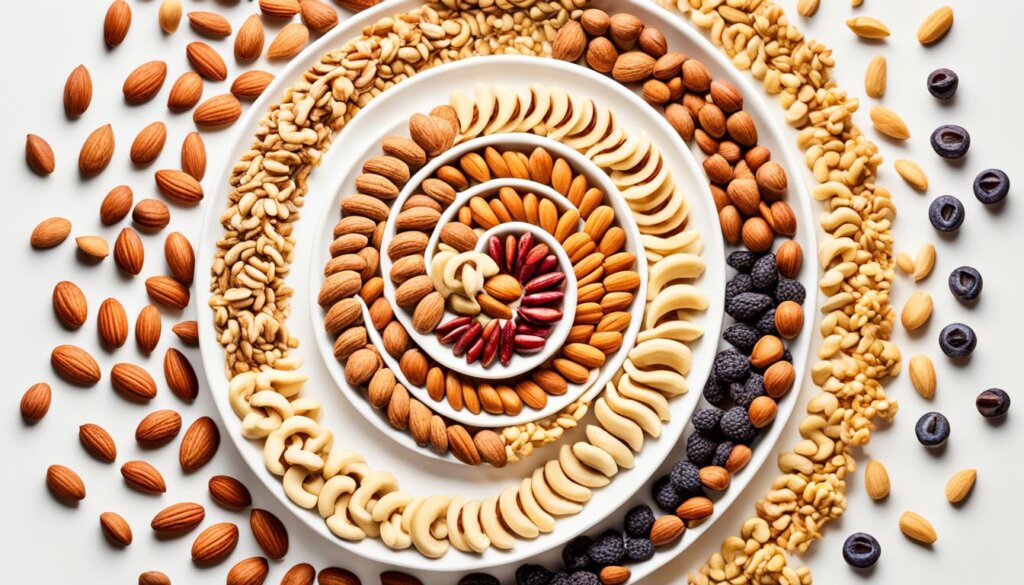
“Nuts and seeds are a game-changer for those on a gluten-free diet. They provide the crunch and fiber you crave, without the wheat.”
Fruits and Vegetables: Naturally Gluten-Free and Fiber-Filled
Going gluten-free doesn’t mean losing out on fiber. And guess what? Fruits and vegetables come naturally gluten-free. They’re also full of the fiber your body craves. Adding these to your meals helps you get the fiber you need without missing out on taste.
Berries: Sweet and Fiber-Packed
Think of berries like blueberries, raspberries, and blackberries. They’re sweet and packed with fiber, too. For example, a half-cup of raspberries gives you 8 grams of fiber. And a medium-sized pear has about 5.5 grams of fiber. These fruits add a tasty crunch and lots of nutrients to any gluten-free meal.
Leafy Greens and Cruciferous Veggies: Nutrient-Dense Fiber Sources
Leafy greens like kale, spinach, and Swiss chard, as well as veggies like broccoli, cauliflower, and Brussels sprouts, are stars when it comes to fiber. They don’t just boost your fiber. They also bring in loads of vitamins, minerals, and antioxidants. With these greens and veggies in your meals, you not only up your fiber game but also treat your taste buds to a gluten-free feast.

Imagine digging into a fresh berry salad, some sautéed greens, or those roasted veggies. These gluten-free, fiber-packed foods can be the heart of your healthy, gluten-free life. And with so many fresh fruits and vegetables out there, getting your daily fiber is a delicious journey your body will thank you for.
“Fruits and vegetables are essential components of a fiber-rich, gluten-free diet, providing a wealth of essential nutrients and satisfying fiber to support your overall health and well-being.”
Gluten-Free Baking with Fiber-Rich Flours
Gluten-free baking has its challenges for fiber. Luckily, there are many gluten-free flours like almond, coconut, and buckwheat. These are great for adding fiber and making tasty treats.
Almond, Coconut, and Buckwheat Flours: Nutritious Alternatives
Almond flour is a favorite for its texture and taste. It’s full of fiber and keeps you full. A cup has about 640 calories, so it’s hearty and satisfying. Coconut flour adds fiber and a unique taste to baked goods.
Buckwheat flour isn’t actually wheat and is high in fiber. It brings a rich, earthy taste to gluten-free baking.
Flour Type | Fiber Content | Nutritional Benefits |
|---|---|---|
Almond Flour | 3 grams per 1/4 cup | High in healthy fats, protein, and antioxidants |
Coconut Flour | 5 grams per 2 tablespoons | Rich in fiber, protein, and healthy fats |
Buckwheat Flour | 4 grams per 1/4 cup | High in fiber, antioxidants, and essential nutrients |
Adding these flours to your gluten-free baking boosts nutrition. It makes for tasty and fulfilling treats. Mix them with other gluten-free choices for the best results.

Finding the right mix for gluten-free baking takes time. With some trial and error, you can discover awesome nutritious, and delicious recipes.
Fiber-Boosting Snack Ideas
In a world where getting enough fiber is hard for many, snacks can help tremendously. More than 90% of women and 97% of men in the U.S. fall short of the daily recommended fiber intake. Yet, making smart snack choices can boost your fiber intake. This way, you get to enjoy the benefits of a fiber-rich diet.
Roasted Chickpeas and Edamame: Crunchy and Satisfying
Roasted chickpeas and edamame are delicious snacks filled with fiber. They provide at least 3 grams of fiber in each serving, around 10% of the daily fiber goal. Add chia seeds for even more fiber. They pack 10 grams of fiber into each 1-ounce serving, which is almost a third of the day’s needs.
Homemade Trail Mixes and Energy Bites
Making your trail mix and energy bites is fun and nutritious. Use high-fiber foods like nuts, seeds, and dried fruit. This adds flavor while upping your fiber intake. Since most Americans get only half the recommended fiber, this is a smart snack move.

Legumes such as beans, peas, and lentils are fiber champs, with 6-8 grams per half-cup. Nuts and seeds like almonds and pumpkin seeds are also great sources. They add about 3 grams of fiber per serving. Including these in homemade snacks significantly boosts your daily fiber.
Choosing fiber-packed snacks is not only good for your gut but also energizing. It helps you meet your nutritional needs easily with a gluten-free diet. Plus, these snacks offer health benefits galore.
High-Fiber Gluten-Free Breakfast Options
Make your mornings great with high-fiber, gluten-free breakfasts. Try overnight oats, chia puddings, granolas, and muffins. They’re full of fiber to keep you full and energized.
Overnight Oats and Chia Puddings
Overnight oats and chia puddings are full of fiber. They’re perfect for busy mornings. Try overnight oats with gluten-free oats and almond milk. Add berries, nuts, or cinnamon. Or, make a chia pudding with chia seeds, plant milk, and fruit.
Gluten-Free Granolas and Muffins
Grab a gluten-free granola or muffin for an easy, fiber-rich breakfast. They’re made with nuts, seeds, and dried fruit for a crunch and fiber boost. Make your own granola with oats, almonds, and coconut. Choose muffins with fiber-rich blueberries, zucchini, or chia seeds.
Start your day right with these options. You can have creamy overnight oats or a quick muffin. There’s something for everyone to stay full and happy.

Ingredient | Fiber Content |
|---|---|
3 tablespoons of Hi Fiber hemp protein | 12g of fiber |
3 tablespoons of Vanilla hemp protein | 5g of fiber |
1 tablespoon of Superseed Blend | 3g of fiber |
1 tablespoon of chia seeds | 5g of fiber |
1 tablespoon of gelatin | 0g of fiber |
1/4 or 1/2 cup of gluten-free oats | 2g or 4g of fiber, respectively |
2 tablespoons of coconut flour | 8g of fiber |
1 tablespoon of L-Glutamine Pure Powder | 0g of fiber |
“Each high-fiber breakfast recipe provides at least 6 grams of fiber per serving, delivering 20% or more of the FDA’s recommended daily value of fiber.”
These breakfast ideas are full of fiber and flavor. They offer options from smooth to crunchy. You’ll find things like avocados, raspberries, chickpeas, and chia seeds in the recipes. So, enjoy a quick smoothie or a hearty bowl of oats. These meals will keep you going all morning.
Meal Prep and Planning for a Fiber-Rich Gluten-Free Diet
Keeping a diet that’s high in fiber but free from gluten can be hard. Yet, with some smart meal planning, you will find it easier. Make sure you fill your kitchen with lots of different foods that are both rich in fiber and gluten-free.
Meal prepping lets you manage what you eat in a day when following a fiber and gluten-free diet. It means you can pick from meals that have the right amount of calories, fat, protein, and fiber. You’ll also get plenty of important vitamins and keep your salt low.
When forming your meals, think about using lots of colorful fruits and veggies like berries, broccoli, and peppers. Add in some gluten-free grains and you’re all set. Don’t forget about legumes, nuts, and seeds. They’re great for extra fiber and easy to include in your meals.
Planning your meals ahead saves a lot of time and worry about what to eat. Spend some time each week getting your meals together. Then, you’ll have healthy meal options that are high in fiber ready whenever you need them.
Choosing a diet that’s both high in fiber and free from gluten should be enjoyable. It’s not only for those who need it for health reasons. With a bit of planning and imagination, your meals can be both tasty and good for you.
Balancing Fiber Intake and Hydration
Adding fiber to your meals is key if you’re avoiding gluten. But, you need to drink enough water. Many Americans don’t get the 25 to 35 grams of fiber they need daily. People on gluten-free diets usually have even less. So, it’s vital to look at how fiber and water go together for good health.
Fiber helps keep your gut healthy. It needs water to work right. For every 1,000 calories, you should aim for 14 grams of fiber. This means about 25 grams each day for women and 38 grams for men. But, most adults in the U.S. only get 10 to 15 grams a day. This low amount can lead to constipation and other problems.
Here’s how to have the right amount of fiber and water on a gluten-free diet:
- Increase fiber intake gradually: Start by adding 5 grams more of fiber a day. Aim to hit 25 to 30 grams daily. Going slow can help avoid tummy troubles.
- Focus on fiber-rich gluten-free foods: Add plenty of fiber-filled foods like quinoa, lentils, and nuts to your diet. Also, choose berries, leafy greens, and beans.
- Stay hydrated: Make sure to drink lots of water every day. Try to have at least 8 glasses (64 ounces) of water. You might need more if you’re very active or it’s warm out.
Finding a balance between fiber and water is important. It helps you get all the good from a fiber-rich gluten-free diet without the tummy troubles. Always pay attention to how you feel. Adjusting your fiber and water as needed can keep you feeling your best.
Exploring Global Cuisines for Fiber-Rich Gluten-Free Inspiration
Look beyond the usual Western food to find a world of exciting fiber-rich, gluten-free meals. You’ll see new ways to add fiber to your diet without gluten. This can make mealtime fun and tasty.
Enjoy the smell of Indian dals and the goodness of South American quinoa. There’s a lot to try in the world’s food. Exploring different cuisines is a great idea for gluten-free eaters.
The market for global flavors is growing fast, with a 7.2% yearly increase expected from 2020 to 2025. Large cities have over 30 different kinds of food to try. Young people are very interested, with 75% of them looking for new foods.
Trying global dishes can introduce you to many fiber-rich, gluten-free goodies. You can find grains from teff and sorghum, legumes from the Middle East, and fresh fruits and veggies from Asia. It adds a healthy twist to your meals.
So, go on a food adventure and try diverse gluten-free meals. Imagine tasting Thai curry, Mexican stew, or a Mediterranean salad. The world’s food is waiting for you.
By choosing global cuisines, you pick meals that are good for you and expand what you know about food. Discover the joy of finding fiber-rich, gluten-free food. It’s a tasty and exciting journey.
Conclusion
We looked at why it’s important to add fiber-rich and gluten-free foods to your diet. Celiac disease impacts about 1.8% of the US population. And, more people are choosing a gluten-free way of life. This includes up to 30% of US adults wanting to cut back on gluten.
Yet, those living gluten-free often find it hard to get enough fiber. People who eat wheat usually get 8 to 10 grams of fiber a day.
Adding nutrient-rich gluten-free foods like quinoa, teff, and millet helps. So does including legumes, nuts, seeds, fruits, and veggies. Try to get 25 to 30 grams of fiber every day. Also, remember to drink plenty of water. This helps with digestion.
With some planning and creativity, enjoying a fiber-filled gluten-free diet is doable. It can help keep you healthy and happy.
It’s all about trying different whole, natural foods. These foods give your body the nutrients and fiber it needs. Making choices that are both rich in fiber and gluten-free is essential. It helps ensure your body stays healthy in the long run.
FAQ
What are the benefits of fiber-rich gluten-free foods?
Fiber-rich gluten-free foods are great for your stomach. They help you feel full and are full of important nutrients for people avoiding gluten. Fiber is very important for your body, and it can be hard to get enough without gluten.
What are some good sources of fiber on a gluten-free diet?
Good places to find fiber on a gluten-free diet are quinoa, teff, sorghum, and millet. You can also eat legumes like chickpeas, lentils, beans, and peas. Don’t forget nuts, seeds, fruits, and veggies. They’re also gluten-free and full of fiber.
How can I incorporate more fiber-rich ingredients into gluten-free baking?
Try using different gluten-free flours like almond, coconut, and buckwheat. These are nutritious and add a lot of fiber to your baking. Using these flours more often can up your fiber intake.
What are some good fiber-boosting snack ideas for a gluten-free diet?
Snacks high in fiber include roasted chickpeas, edamame, and homemade trail mixes. You can also make energy bites with nuts, seeds, and dried fruits for a fiber boost.
How can I balance fiber intake with proper hydration on a gluten-free diet?
When you’re eating lots of fiber, make sure you drink enough water. Finding the right balance between fiber and water is key to staying healthy and comfortable.
